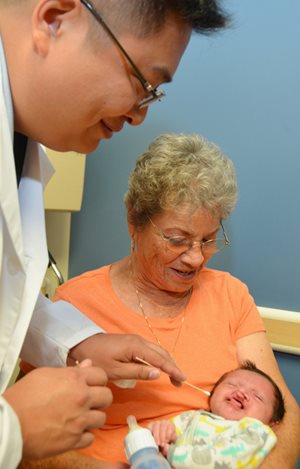Baby Zeniya was taken to the UCSF Fresno - Community Medical Centers Cleft and Craniofacial Center for help.
A team approach at the UCSF Fresno Cleft and Craniofacial Center
Thousands of infants, children and teens are affected by cleft and craniofacial conditions each year in the U.S. Fortunately for Zeniya and others in the Central Valley, UCSF Fresno and Community Medical Centers has a Cleft and Craniofacial Center with an interdisciplinary care team who work together to provide care to patients from birth to young adulthood.
The Center is a designated Specialty Care Center for Cleft and Craniofacial Care by California Children’s Services.
The Center is a designated Specialty Care Center for Cleft and Craniofacial Care by California Children’s Services.
The Interdisciplinary Team includes:
-
Pediatrics Physicians
-
Speech Language Pathologists
-
Team Nurse Coordinator
-
Dietitian
-
Child Psychiatry
-
Pediatric Dentistry
-
Prosthodontics
-
Ear, Nose and Throat Specialists
-
Genetics
-
Orthodontics
-
Social Worker
Neonatal jaw reconstruction surgery
In Zeniya’s case, it was determined she would need neonatal jaw reconstruction surgery to correct her jaw and open her airway.
Dr. Zakhary, DDS, MD, FACS, Director of Cleft & Craniofacial Surgery at the Cleft and Craniofacial Center, was there to help. In this procedure, Dr. Zakhary explained cuts are made into the patient’s jaw bone and a distraction device is inserted. The device has a small arm that sticks out behind the ear and it is turned every day to grow the patient’s jaw bone. Over time, the bone will fill in where it’s been elongated.
 “That pulls her tongue forward, opens up her airway, gives her a normal appearance in her lower jaw, and now [Zeniya] is at her normal by-mouth feeds,” Dr. Zakhary said.
“That pulls her tongue forward, opens up her airway, gives her a normal appearance in her lower jaw, and now [Zeniya] is at her normal by-mouth feeds,” Dr. Zakhary said.
Dr. Zakhary, DDS, MD, FACS, Director of Cleft & Craniofacial Surgery at the Cleft and Craniofacial Center, was there to help. In this procedure, Dr. Zakhary explained cuts are made into the patient’s jaw bone and a distraction device is inserted. The device has a small arm that sticks out behind the ear and it is turned every day to grow the patient’s jaw bone. Over time, the bone will fill in where it’s been elongated.
 “That pulls her tongue forward, opens up her airway, gives her a normal appearance in her lower jaw, and now [Zeniya] is at her normal by-mouth feeds,” Dr. Zakhary said.
“That pulls her tongue forward, opens up her airway, gives her a normal appearance in her lower jaw, and now [Zeniya] is at her normal by-mouth feeds,” Dr. Zakhary said.A new outlook
Just a short time later, Zeniya is feeding through her mouth and gobbling down her food — her mother Stephanie Vargas said. Her team of medical professionals will continue to follow her as she grows and her bones mature. When she’s about a year old, they will fix her cleft palate.
Vargas said couldn’t be more thankful for Dr. Zakhary and the rest of the professionals at the Cleft and Craniofacial Center, “I just feel like they were put in my path for a reason. They were put in Zeniya’s path for a reason.”
Vargas said couldn’t be more thankful for Dr. Zakhary and the rest of the professionals at the Cleft and Craniofacial Center, “I just feel like they were put in my path for a reason. They were put in Zeniya’s path for a reason.”
State-of-the-art craniofacial care & expertise
Cases like Zeniya’s aren’t the only ones treated at the Cleft and Craniofacial Center. Cleft and Craniofacial conditions include orofacial birth defects, as well as conditions acquired by trauma, burns and disease. The Center, which is affiliated with UCSF Benioff Children’s Hospital, provides state of the art care for all children with cleft and craniofacial abnormalities.
Cleft and Craniofacial Center expertise includes, but is not limited to:
Cleft and Craniofacial Center expertise includes, but is not limited to:
-
Apert Syndrome
-
Cleft lip
-
Cleft palate
-
Craniofacial anomalies
-
Craniosynostosis (fused skull, abnormal head shape, abnormal skull sutures)
-
Crouzon
-
DiGeorge Syndrome (22q deletion)
-
Facial trauma
-
FAV spectrum
-
Head and neck tumors and cysts
-
Hemifacial microsomia
-
Hypernasality
-
Malocclusion
-
Micrognathia
-
Microtia
-
Pierre Robin
-
Plagiocephaly
-
Stickler’s Syndrome
-
Treacher-Collins
-
Van der Woude Syndrome
-
Velocardiofacial Syndrome
-
Velopharyngeal insufficiency
For more information, contact the UCSF Fresno Cleft and Craniofacial Center.







